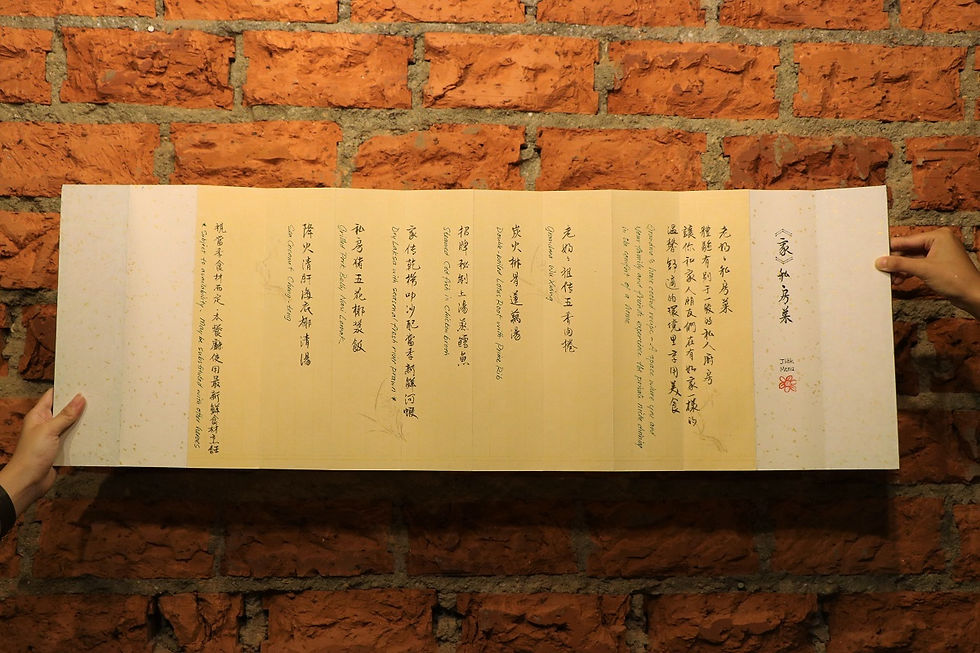JIAK/家: Heartwarming Private Home Dining with Unique Singaporean-Style Omakase
- Cheryl Teo
- Dec 19, 2018
- 7 min read

Home is where the heart is, and there indeed is plenty of heart in this culinary-centered home. JIAK/家 is a private home dining concept that immerses its diners in a contemporary Asian home ambiance while they feast on the epitome of Singaporean cuisine. The name of this private home dining experience is laden with three heartwarmingly punny meanings. The friendly team who opened their hearts and their home to diners in search of superior local fare, colloquially and endearingly labeled the private home dining experience JIAK, which means "eat" in Hokkien. Additionally, the name is a play on the Chinese word "家" (pronounced "jia"), which means home. JIAK is also a malapropism of its location address, "joo chiat" being said really fast. You can't help but marvel at the wittiness and effort that went into conceiving just the name itself.

JIAK's handwritten monthly menu
The omakase culture has been rapidly gaining traction in Singapore, with a dime a dozen Japanese omakase experiences promising the very best culinary delights directly airflown from Japan several times a week. But perhaps it is time to go back to our roots and embrace our vibrant local cuisine that has once made our culinary scene flourish from years long past. In the age of globalization and technological advances that brought the world closer together, the movement also brought a tidal wave of demand for exotic and foreign cuisines. As a result, Singapore's diverse heritage foods were sadly left behind in the dust with the revolution and modernization of fine gastronomy. JIAK aims to revive Singapore's fading food heritage and bring it back onto the table with a carefully curated menu of traditional local fare prepared from scratch with superlative ingredients and tweaked with elements of modern luxury. This unique Singaporean-style omakase, that costs $70 per pax, consists of a six-course menu that changes up every month. Even though the menu is completely revamped on a monthly basis, every dish may slightly differ from day to day, as the fastidious chef demands the freshest produce obtainable. Only the best daily ingredients are incorporated in the menu, so you can rest assure that the quality of your dishes are of utmost superiority.

JIAK's location
JIAK is situated in an old-school low-rise walk-up apartment, which is rather befitting considering that it serves traditional Singaporean cuisine made with secret recipes passed down from multiple generations. The apartment is located along the quiet stretch of Joo Chiat Place (not to be confused with Joo Chiat Road). Look for the neon yellow letterbox that indicates 184B Joo Chiat Place, and ascend the stairs next to it until you reach an imposing metal gate that leads to more stairs. The gate is always left unlocked just before dinner time, so you can simply swing it open and continue walking up another flight of stairs thereby reaching the door that leads into JIAK.


With a knock on the door, you are warmly welcomed into the humble abode where it will be transformed into a paradisaical refuge in the evening, showcasing Singapore's legendary local gastronomy. The dining area is set against the backdrop of a red-brick wall, and illuminated by caged Edison bulbs dripping from the ceiling. The smooth dark-oak flooring in the dining room is luxurious to walk on, and it extends to a living area, separated by sliding glass doors, where you can chill out with an aperitif or watch TV before dinner is served.

The open-concept kitchen built just adjacent to the dining room allows diners to interact with Chef Anon and watch him in action as he employs the traditional culinary techniques that has been honed and perfected by his ancestors who have been chefs of local cuisine for multiple generations.


A small black spiral staircase hidden in a corner of the kitchen leads up to a rooftop terrace with a 360 view of the neighboring estates. I highly recommend arriving earlier with a bottle of wine so that you and your dinner companions can enjoy several glasses of wine on the roof while catching the sunset just before dinner time. Foie Gras Ngoh Hiang

This has got to be one of the most innovative and unique ways to enjoy ngoh hiang and foie gras collectively, and also what I assume to be an extremely painstaking task to assemble. Foie gras purée and chopped water chestnuts are encased within a thin layer of beancurd skin. The fragile beancurd skin though thin and friable, crackles in the mouth which delivers the perfect textural contrast to the rich, creamy, melty and velvety foie gras within. The foie gras imbues the ngoh hiang with its umami, musky, funky and slightly fruity essence, while the minced water chestnuts balances out the richness of the foie gras with its watery and refreshing crunch.
Double-Boiled Lotus Root Soup with Prime Rib

This prized little crock of soup will seduce your tastebuds and warm the cockles of your heart with its classic and nutritious Chinese taste melding into an innovative multi-dimensional weave of textures and flavors. Double-boiled for 48-hours over charcoal, this bowl of lotus root soup carries a strong earthy fragrance that evokes a comforting sense of childhood nostalgia for diners brought up in Chinese households where herbal soups are regarded to play a crucial role in the development of the mind and body. The soup is hearty, robust, full-bodied and teeming with generous portions of lotus root, pork rib, dried octopus, peanuts, red dates and goji berries. The lotus root and peanuts give the soup an intense woody flavor that balances out the sweetness of the red dates and goji berries. The chunks of pork rib are soft and fatty yet retaining a nice bite instead of disintegrating into a mush. The dried octopus is springy and tender, with the concentrated flavors of the ocean stored in its flesh contributing to a touch of sweet marine saltiness to the soup. Steamed Codfish in Chicken Broth

Doused in a light yet flavorful chicken broth amalgamated with soya sauce that is piquant, fragrant and salty, the buttery white flesh of the steamed cod, which is caught fresh daily, melts from the heat of the tongue, setting the mouth awash in a delicious blend of fatty, gelatinous and viscous Omega-3 juices. The pool of soya sauce chicken broth that the fish sits in is thin, yet rich and flavorful, heavily infused with the sweetness of chicken and savory umami quality of the soya sauce. It is topped with fruity sweet goji berries, crispy and sharp ginger slices and ever-green parsley that softens the vivid oceanic flavors of the cod. Dry Laksa with Seasonal Fresh River Prawn

This dry laksa dish is a more concentrated version of the famous Peranakan spicy soup noodles. The gravy is thicker, creamier and more flavorful than its traditional counterpart. Superior dried shrimps (hae bee), lemongrass, garlic, chili, and a whole bunch of other ingredients are ground down into a paste before it is fried for a lengthy duration to allow all the flavors of the ingredients to thoroughly coalesce. The fried paste is then tediously boiled down with prawn bisque and coconut milk in a cauldron till it thickens to ensure a rich and robust flavored laksa sauce. The rich laksa sauce is thick, rich, creamy, spicy and fragrant, with a smooth and velvety texture. The addition of lemongrass cuts through the creamy gravy with its citrusy tang and prevents the sauce from overwhelming the palate. The luscious gravy contains just the right amount of spice to prickle the tongue with the perfect measure of coconut milk to balance out the spiciness and inculcate the dish with a delicate sweetness and fragrance. The dried shrimps have been thoroughly infused into the concoction, suffusing the gravy with its savory and umami crustacean flavors. The lagoon of creamy laksa gravy thoroughly permeates, coats and seeps into every molecule of the silky noodles and spongy and porous tau pok (fried bean curd), rendering each morsel to be richly saturated in its spicy, hearty and full-bodied flavors. This bowl of noodles is served with a plump, succulent and springy Cambodian river prawn, topped with crunchy bean spourts and apportioned with a side of sambal belacan (chili shrimp paste) for diners to deepen its spicy umami flavors if they so wish. Grilled Pork Belly Nasi Lemak

Each mini plate of nasi lemak is served with a halved lava egg that has been steeped and marinated in soy sauce and mirin. The molten golden core of the egg explodes upon impact, further intensified by the savory and umami flavors of the marinated egg white. The lava egg is divine, and definitely a much more sumptuous upgrade from the typical hard-boiled egg with its overcooked and hardened yolk. The egg is best eaten in chunks with the coconut rice for a creamy texture and bigger flavor.
The fluffy, aromatic and creamy pandan-coconut rice sits on a segment of banana leaf that amplifies the fragrance of the dish. The quintessential sides of salty ikan billis (dried anchovies) and peanuts add a lovely crunch and a savory tinge with each spoonful of rice. The pork belly satay is seasoned in saffron, turmeric, brown sugar and other dry ingredients before it is flame-grilled on high heat so that the meat and its marinate caramelize and meld together in glistening resplendence. The smoky pork's flame-licked edges emit a hint of charred sweetness, while the meat melts in the mouth with the globs of fat layered in abundance bursting with a surge of fatty and delectable juices.
This tapas portion of nasi lemak comes with a side of julienned cucumbers, fresh and crisp, wonderfully complementing the sweet and spicy sambal chili with just the right amount of kick. Sea Coconut Cheng-Tng

The Chinese have an arsenal of dessert soups boasting a myriad of health benefits, but probably the most refreshing of them all is Cheng Tng, which literally translates to “clear soup”. This light and cooling dessert contains a surfeit of vitamins that help in repelling heat in the body, serving as an anti-inflammatory, retaining youthful skin, and revitalizing the tastebuds with its sweet and delicate flavors. This Teochew dessert consists of sea coconut, dried longans, gingko nuts, barley, red dates, winter melon, white fungus, and honey rock sugar. The sea coconut is simultaneously gelatinous and crunchy, the dried longans are fruity and fleshy, the gingko nuts carry a crunch, and the white fungus has a nice bouncy bite to it. This invigorating soup uplifts the palate and finishes the hearty feast on a sweet and restorative note.
There is only one seating every evening at JIAK, either at 6.30pm or 7pm. Reservations should be made at least three days in advance. A minimum of two pax is required for a reservation, and the maximum capacity is 10 people. The omakase is $70 nett per person. Whiskies, beers and soft drinks are available at an additional charge. To further elevate your dining experience, you may wish to opt for whiskey pairing. JIAK's in-house whiskey connoisseur has prepared a line-up of boutique whiskies that will complement your meal for $12 to $15 per dram. Book your private home dining experience with JIAK by calling or texting +65 82842758 or +65 91796533.
JIAK/家 Address: 184B Joo Chiat Place, Singapore 427896 Hours: 6.30pm/7pm – Late (by reservation only) Tel.: +65 82842758 / 91796533
Facebook: https://www.facebook.com/jiak2gather Instagram: https://www.instagram.com/jiak2gather








Comments